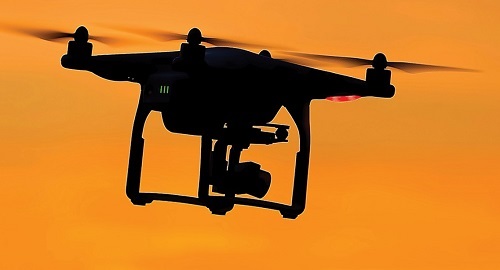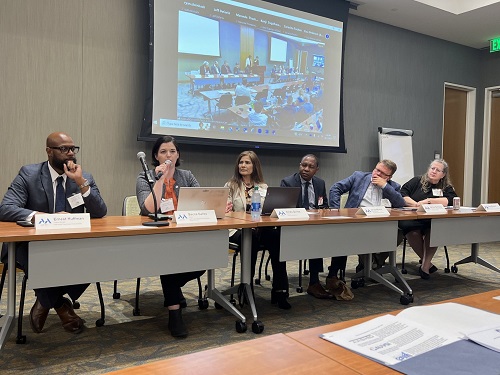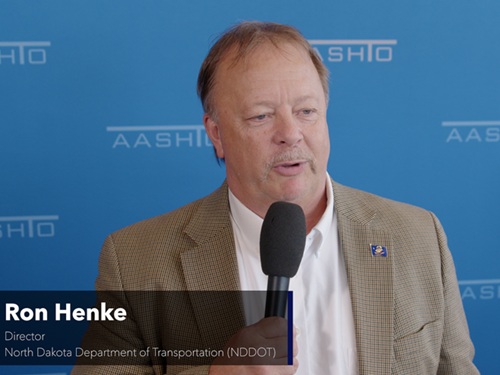The Federal Aviation Administration is holding its 2024 Drone and Advanced Air Mobility Symposium July 30 through August 1 at the Baltimore Convention Center in Maryland.
[Above image by the FAA]
The agency noted in a statement that this annual symposium will bring together representatives from the FAA, other government agencies, international aviation experts, industry leaders and academia.
The presenters and panelists will discuss the latest information and advancements related to the diverse uses of drones and the safe integration of Advanced Air Mobility or AAM aircraft, such as air taxis, into the National Airspace System.

[Editor’s note: The FAA released an implementation plan in July 2023 detailing the steps it and other aviation sector stakeholders must take to safely enable AAM operations in the near term. That “Innovate28” plan includes various components and the sequence in which they will occur for operations to be at scale at one or more sites by 2028.]
The theme for the 2024 symposium is “Connected Skies / Connected Communities.” Sessions and workshops will focus on how the FAA continues to safely integrate drones while creating a regulatory and operational framework to accelerate advanced operations such as beyond visual line of sight operations, as well as traffic management tactics for drones. The agency said the conference’s AAM sessions and workshops will focus on how air taxis and electric vertical take-off and landing or “eVTOL” aircraft will impact the aviation sector.
For more details about the symposium, as well as registration information, click here.
The American Association of State Highway and Transportation Officials, along with its member departments, have been working closely with federal agencies to address a variety of drone and AAM issues over the last several months. Concurrently, many state departments of transportation are engaged in their own drone/AAM testing and system integration efforts.

For example, state members and AASHTO staff attended the U.S. Department of Transportation’s AAM Interagency Working Group meeting February 21-23 in Ft. Worth, TX, to offer insights into AAM planning and implementation efforts at the state and local level.
The meeting represented an effort to emphasize community engagement by bringing together federal, state, and local government officials with industry stakeholders to provide input to help develop USDOT’s National AAM Strategy.
Additionally, in a comment letter filed in August 2023 with USDOT, AASHTO provided advice regarding short- and long-term efforts to help establish the AAM sector. AASHTO noted in its letter that state DOTs played a “vital role” in the development and deployment of new aviation technologies related to AAM – particularly where drones are concerned, using them to fulfill crucial agency functions such as bridge inspections and traffic incident response.
In terms of state-level activity, the Alaska Department of Transportation & Public Facilities and the Alaska Railroad Corporation used Drone Avalanche Reduction Technology or DART developed by Drone Amplified to test drone-based avalanche mitigation technology; a system that uses Uncrewed Aerial System or UAS craft to place and then remotely trigger explosives to create controlled avalanches in order to protect transportation infrastructure.
The Alaska DOT&PF said the goal is the program is to shift away from the use of artillery-based avalanche mitigation techniques to ones that rely on drones.
And in December 2023, the FAA issued a wide-ranging drone waiver to the aeronautics division of the Massachusetts Department of Transportation that allows the agency to fly uncrewed aircraft over the state’s entire railroad network outside the remote drone operators’ fields of vision.
Known as operating “Beyond Visual Line of Sight” or “BVLOS,” that capability allows MassDOT drones to more efficiently collect data on more than 1,000 miles of rail track when monitoring for impediments such as vegetation encroachment, flooding, or storm damage.
MassDOT partnered with the Massachusetts Bay Transportation Authority or MBTA and MITRE Corp. to devise a unique “blended” performance-based approach, providing flexibility to adjust operations according to variations in factors such as geography, urban density, or airspace.
 Nation
Nation
North Dakota DOT Profiled in State DOT Update
July 3, 2025 Nation
Nation

